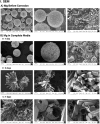Reduction reactions dominate the interactions between Mg alloys and cells: Understanding the mechanisms
- PMID: 39687558
- PMCID: PMC11647666
- DOI: 10.1016/j.bioactmat.2024.11.020
Reduction reactions dominate the interactions between Mg alloys and cells: Understanding the mechanisms
Abstract
Magnesium (Mg) alloys are popular biodegradable metals studied for orthopedic and cardiovascular applications, mainly because Mg ions are essential trace elements known to promote angiogenesis and osteogenesis. However, Mg corrosion consists of oxidation and reduction reactions that produce by-products, such as hydrogen gas, reactive oxygen species, and hydroxides. It is still unclear how all these by-products and Mg ions concomitantly alter the microenvironment and cell behaviors spatially and temporally. This study shows that Mg corrosion can enhance cell proliferation by reducing intracellular ROS. However, Mg cannot decrease ROS and promote cell proliferation in simulated inflammatory conditions, meaning the microenvironment is critical. Furthermore, cells may respond to Mg ions differently in chronic or acute alkaline pH or oxidative stress. Depending on the corrosion rate, Mg modulates HIF1α and many signaling pathways like PI3K/AKT/mTOR, mitophagy, cell cycle, and oxidative phosphorylation. Therefore, this study provides a fundamental insight into the importance of reduction reactions in Mg alloys.
Keywords: Alkaline pH; Electrochemical reactions; Magnesium alloys; Mg ions; Reactive oxygen species.
© 2024 The Authors.
Conflict of interest statement
The authors declare the following personal relationships which may be considered as potential competing interests: Haobo Pan is currently employed by Shenzhen Healthemes Biotechnology Co. Ltd. Haobo Pan is an editorial board member for Bioactive Materials and was not involved in the editorial review or the decision to publish this article.
Figures













Similar articles
-
Ion channel functional protein kinase TRPM7 regulates Mg ions to promote the osteoinduction of human osteoblast via PI3K pathway: In vitro simulation of the bone-repairing effect of Mg-based alloy implant.Acta Biomater. 2017 Nov;63:369-382. doi: 10.1016/j.actbio.2017.08.051. Epub 2017 Sep 4. Acta Biomater. 2017. PMID: 28882757
-
Development of magnesium-based biodegradable metals with dietary trace element germanium as orthopaedic implant applications.Acta Biomater. 2017 Dec;64:421-436. doi: 10.1016/j.actbio.2017.10.004. Epub 2017 Oct 4. Acta Biomater. 2017. PMID: 28987782
-
Cytocompatibility and early inflammatory response of human endothelial cells in direct culture with Mg-Zn-Sr alloys.Acta Biomater. 2017 Jan 15;48:499-520. doi: 10.1016/j.actbio.2016.10.020. Epub 2016 Oct 13. Acta Biomater. 2017. PMID: 27746360 Free PMC article.
-
Prospects and strategies for magnesium alloys as biodegradable implants from crystalline to bulk metallic glasses and composites-A review.Acta Biomater. 2020 Feb;103:1-23. doi: 10.1016/j.actbio.2019.12.023. Epub 2019 Dec 24. Acta Biomater. 2020. PMID: 31881312 Review.
-
Current status and perspectives of zinc-based absorbable alloys for biomedical applications.Acta Biomater. 2019 Oct 1;97:1-22. doi: 10.1016/j.actbio.2019.07.034. Epub 2019 Jul 24. Acta Biomater. 2019. PMID: 31351253 Review.
References
-
- Global metal implants and medical alloys market size, share, growth analysis, by material type (titanium and titanium alloys, stainless steel), by product type(orthopedic implants, dental implants), by application (Joint replacement, trauma and orthopedic surgeries) - industry forecast 2023-2030. Skyquest. 2024 https://www.skyquestt.com/report/metal-implants-and-medical-alloys-marke... %20is%20the%20global%20market,period%20(2023%2D2030)
LinkOut - more resources
Full Text Sources
Miscellaneous

